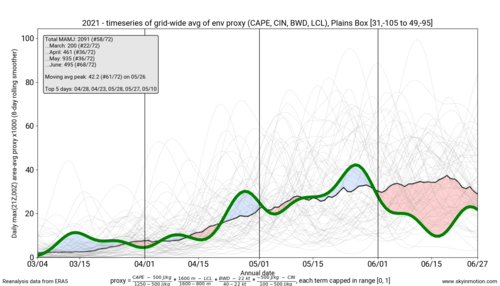SPRING 2021 TAKEAWAYS:
- Yet another down year in terms of classically favorable patterns and environments on the Plains.
- Relative to the pattern, though, I'd say this spring was impressively productive in terms of the tornado-day count (and even quality-tornado-day count).
- With nearly incessant eastern Canada troughing, most of the action was shunted SW into the southern High Plains; W TX in particular had its most productive season in quite some time.
- Another repeat theme from recent seasons was the sharp mid-late May peak, which offered the only sustained stretch of chase opportunities. Still, both April and June at least had a small handful of solid, overperforming setups.
- The month of June as a prospect for sustained, quality chasing and traditional Plains setups continued its death spiral. More on that at the bottom of the post.
- Overall, I think hardcore chasers will remember 2021 somewhat fondly as a season that made lots of lemonade out of lemons; more selective folks will remember it as yet another in a string of seasons that never got off the ground and busted virtually every time there was potential for even a borderline obvious tornado setup (5/23, 5/26, 6/24).
MY PERSONAL SEASON:
- Easily my best spring since 2016, which isn't saying a ton. Four tornado days that were all solid in quality, along with a few good to great structure days.
- I had at least one quality tornado day in each of April, May, and June. After 16 years, the only other spring seasons I can say that for are 2010 and 2015.
- In light of the background pattern and setups, I most definitely view luck as having been on my side this year. I easily could have sat out or otherwise botched any of my tornado days had a butterfly in Madagascar flapped the wrong way that morning.
- My success rate was still low, as it's tended to be lately. Like many addicts, my standards have sunk quite a bit during this era of scarcity since the mid-2010s, and I somehow find myself 4-8 hours from home at times for nothing more than hope-and-pray setups. This year, I felt like that approach actually paid off nicely with ~30% of those setups going off, as opposed to the pure punishment it delivered in 2018 and 2020.
- In keeping with the prevailing synoptic pattern, I saw tornadoes in areas I haven't before, most notably my first in NM and farthest west (105 W). The Vernon (4/23) and Sudan (5/16) storms were also in areas where I've had minimal success over the years, having come to associate the NW TX/South Plains region with inevitable HP grunge until now.
- With all that said, I'm still left pining for something halfway near a typical active season from the 90s-00s. Maybe it's just me, but half the enjoyment derived from legendary chase days is the anticipation, and it's been *years* since we've had something to drool over for several days in advance that actually delivered the goods.
OBJECTIVE SUMMARY BASED ON ERA5 REANALYSIS:
I'm still tweaking and honing a technique for tracking "chase-favorable environments" in the ERA5 reanalysis dataset, which now covers 1950-present. Details aside, what I've got right now identifies grid points where CAPE, bulk shear, and LCLs are at least reasonably supportive of tornadic supercells, and CIN is not prohibitive. This is vaguely like SCP, but also quite different: low-level shear isn't considered, LCL is considered, and each ingredient's contribution is capped once it reaches a reasonably favorable threshold (e.g., >1250 J/kg CAPE or <800 m LCL). Qualitatively, I'm trying to get at "how favorable was the pattern this year, and how did the pattern evolve through the course of the season?" without allowing more sensitive ingredients like SRH to introduce noise. Also, I'm currently evaluating the environment at both 21z and 00z each day, taking the more favorable of the two at each grid point.
So here's what I've got for March-June 2021 over the Plains. Note that these time series are smoothed over an 8-day window, so you can interpret values as something like: "how active was the week centered on this date?" This year's values are the bold green curve; the 72-year median is black; and all 71 of the other years since 1950 are shown as thin gray curves in the background.

Relative to 1950-2021 climatology, we were doing alright until the end of May: the coverage of favorable Plains environments oscillated around the 72-year median without any huge anomalies. In other words, there were no classically active periods, but any dead periods were also short lived. That's for damn sure more than you could say in 2018 and 2020.
Then, right on cue, the bottom fell out in June. Supportive environments in early-mid June over the past decade have been quite anomalously scarce, and the falloff is especially jarring given the tendency for May 15-25 to be more active than normal over the same period. I may do a longer post with more results from this environment-coverage metric later this summer -- there are likely broader takeaways about our perceptions of Plains spring climo derived from chasing a limited set of years vs. what 70 years of reanalysis can tell us.

